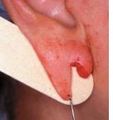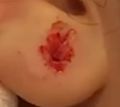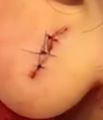Difference between revisions of "Ear lobe Repair"
(Created page with " Category:Otology Ear lobe repair is the most common request in cosmetic surgery. Torn ear lobes result from various forms of trauma, which include: 1. Babies pulling...") |
|||
| Line 56: | Line 56: | ||
5. Ear rings are ideally removed before taking off the upper clothing. | 5. Ear rings are ideally removed before taking off the upper clothing. | ||
| + | |||
| + | |||
| + | <gallery> | ||
| + | Elliptical_punch.JPG|Elliptical_punch | ||
| + | Tongueblade_stabilization.JPG|Tongue blade stabilization | ||
| + | Earlobe_tear.JPG|Earlobe Tear | ||
| + | Chalazion_clamp.jpg|Chalazion clamp used to stabilize the ear lobe | ||
| + | |||
| + | Scar_removed.JPG|Scar tissue removed | ||
| + | |||
| + | Lat_suture.JPG|Lateral portion of ear lobe sutured | ||
| + | |||
| + | </gallery> | ||
Latest revision as of 07:36, 30 May 2019
Ear lobe repair is the most common request in cosmetic surgery. Torn ear lobes result from various forms of trauma, which include:
1. Babies pulling ear rings
2. Entanglement in telephone cords
3. Hair brushes
4. Caught in the cloathing
5. Spousal abuse
6. Heavy ear rings
Some of the ear lobe tears occur over years of constant weight of heavy, pendulous ear rings. Patients fail to seek immediate care when the ear lobe is acutely torn causing the torn edges of the lobe becoming epithelialized thus forming a fistula or cleft. All the currently available methods of earlobe repair concerns the removal of the scar tissue and some type of approximation of the fresh edges.
Ear lobe repair is usually performed under local anesthesia. 2% xylocaine with 1 in 100,000 units adrenaline is used as the local anesthetic. About 0.5 ml of this drug is injected at the root of the ear lobe to anesthetize the area.
Since the ear lobe is the most fleshy and mobile areas of the body it should be controlled and stabilized before attempting the repair. Common stabilization modalities include the use of skin hooks, chalazion clamps and sterile tongue blades (wooden straight ones).
Incision:
Common incisional modalities include scar excision with scalpel / scissors. Incision should be performed in a pressure less manner. Radiofrequency cautery has also been used for this purpose. It offers precision, and simultaneous cutting and coagulation. The frequency used is 4.0 MHz. Some authors also prefer using CO2 laser.
Small tears involving the upper two thirds of ear lobe can just be incised. The enlarged fistula can be repaired by approximating the lateral and medial surfaces. It is not mandatory for converting these tears into a full one. Some authors prefer using elliptical biopsy punch forceps. 6-0 silk is ideal. Some authors use 6-0 chromic catgut which need not be removed.
Incomplete tears that are at or below the junction of the lower third of the ear lobe should be converted into a full tear. Failure to include the inferior border of the lobe margin can result in bunching and elongation of the earlobe.
When repairing full thickness ear lobe tear a single buried 5-0 absorbable suture is used. This reduces the dead space and diminishes the tension on the skin sutures.
The lateral surface of the ear lobe is sutured first, this will enable a minor irregularity to be hidden behind the earlobe.
Re piercing ear lobe:
This can be done immediate. This is viable because the patient can leave the OT with an ear ring which can be worn throughout the healing period.
Complications:
!. Depressed linear scar. This can be treated by resurfacing with Co2 laser.
2. Inferior notching of the lobe. This is due to improper alignment of the inferior lobe or from scar retraction. Everting the closure and placing a key suture will reduce the incidence of this complication.
Prevention of ear lobe tears:
1. Avoid wearing heavy ear rings for long periods of time
2. The ear rings can be removed while using the phone
3. Ear rings to be removed when in saloon
4. Children should not be allowed to wear small loop or dangling ear rings
5. Ear rings are ideally removed before taking off the upper clothing.




